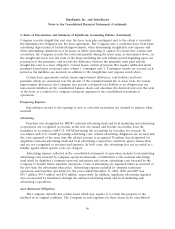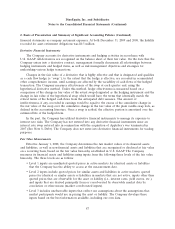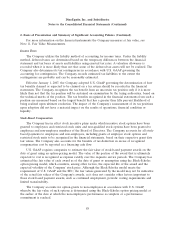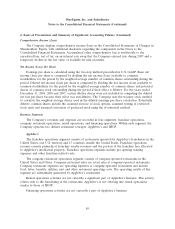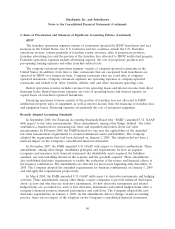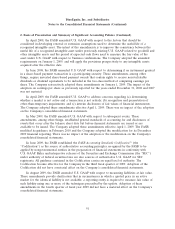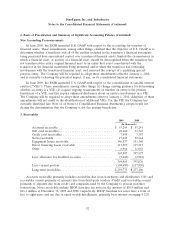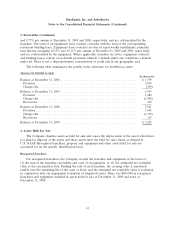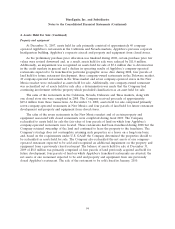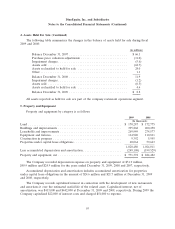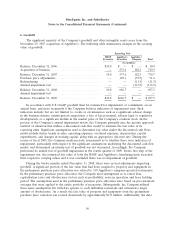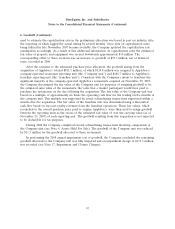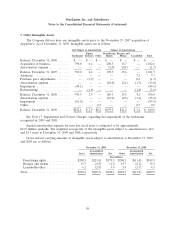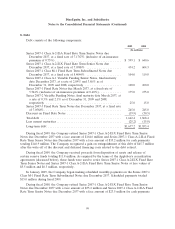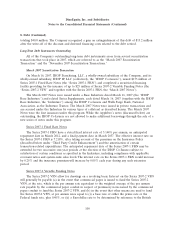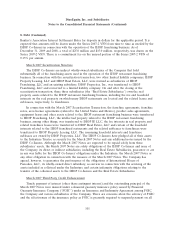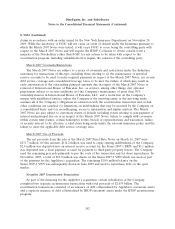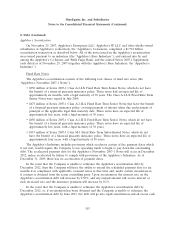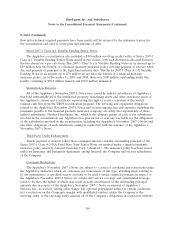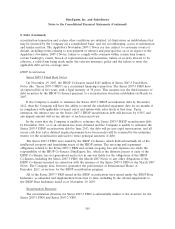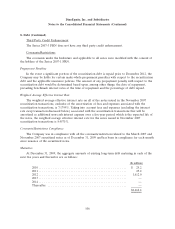IHOP 2009 Annual Report Download - page 115
Download and view the complete annual report
Please find page 115 of the 2009 IHOP annual report below. You can navigate through the pages in the report by either clicking on the pages listed below, or by using the keyword search tool below to find specific information within the annual report.
DineEquity, Inc. and Subsidiaries
Notes to the Consolidated Financial Statements (Continued)
6. Goodwill
The significant majority of the Company’s goodwill and other intangible assets arose from the
November 29, 2007 acquisition of Applebee’s. The following table summarizes changes in the carrying
value of goodwill:
Reporting Unit
IHOP Applebee’s Applebee’s
Franchise Franchise Company Total
(In millions)
Balance, December 31, 2006 ........................ $10.8 $ — $ — $ 10.8
Acquisition of business ............................ — 537.6 182.3 719.9
Balance, December 31, 2007 ........................ 10.8 537.6 182.3 730.7
Purchase price adjustments ......................... — 149.1 (57.5) 91.6
Refranchising ................................... — — (11.3) (11.3)
Annual impairment test ........................... — — (113.5) (113.5)
Balance, December 31, 2008 ........................ 10.8 686.7 — 697.5
Annual impairment test ........................... — — — —
Balance, December 31, 2009 ........................ $10.8 $686.7 $ — $ 697.5
In accordance with U.S GAAP, goodwill must be evaluated for impairment, at a minimum, on an
annual basis, and more frequently if the Company believes indicators of impairment exist. Such
indicators include, but are not limited to, events or circumstances such as a significant adverse change
in the business climate, unanticipated competition, a loss of key personnel, adverse legal or regulatory
developments, or a significant decline in the market price of the Company’s common stock. In the
process of the Company’s annual impairment review, the Company primarily uses the income approach
method of valuation that utilizes a discounted cash flow model to estimate the fair value of its
reporting units. Significant assumptions used to determine fair value under the discounted cash flows
model include future trends in sales, operating expenses, overhead expenses, depreciation, capital
expenditures, and changes in working capital, along with an appropriate discount rate. During the
course of fiscal 2009, the Company made periodic assessments as to whether there were indicators of
impairment, particularly with respect to the significant assumptions underlying the discounted cash flow
model, and determined an interim test of goodwill was not warranted. Accordingly, the Company
performed its annual test of goodwill impairment in the fourth quarter of 2009. In the first step of the
impairment test, the estimated fair value of both the IHOP and Applebee’s franchising units exceeded
their respective carrying values and it was concluded there was no impairment of goodwill.
During the twelve months ended December 31, 2008, there were several adjustments impacting
goodwill. A significant portion of the fair value that had been assigned to property and equipment in
the preliminary purchase price allocation was related to 510 Applebee’s company-operated restaurants.
In the preliminary purchase price allocation, the Company used assumptions as to rental data,
capitalization rates and obsolescence factors such as profitability, years in operation and lease holding
period. The assumptions used in the preliminary purchase price allocation were based on per-restaurant
averages that were applied to the entire portfolio of properties. Subsequently, the Company utilized
these same assumptions but with data specific to each individual restaurant and estimated a larger
amount of obsolescence. As a result, the fair value of property and equipment from the preliminary
purchase price valuation was revised downwards by approximately $133 million. Additionally, the data
96


